Development of Site-Specific Wind Hazard Map for Peninsular Malaysia via Spatial Modeling
Abstract
1. Introduction
2. Research Methodology
2.1. The Location of the Study
- Northern Region: Perlis, Kedah, Pulau Pinang, Perak
- East Coast Region: Kelantan, Terengganu, Pahang
- Central Region: Selangor, Kuala Lumpur
- Southern Region: Negeri Sembilan, Melaka, Johor
2.2. The Wind Hazard Map Development
2.2.1. Basic Wind Speed Map
2.2.2. Terrain Height Multiplier Mapping
2.2.3. Topographic Wind Multipliers
2.3. Wind Hazard Maps Validation
2.3.1. Histogram Analysis
2.3.2. Skewness Analysis
2.3.3. Cumulative Distribution Function
3. Results
3.1. Windstorm Database
Validation of the Obtained Windstorm Database
3.2. Geodatabase Data Classification
3.2.1. Land Use and Land Cover Data
3.2.2. Data Hill Shape Multiplier
3.3. Development of Wind Hazard Map
3.4. Statistical Analysis and Validation
4. Conclusions
- The Northern Region of Peninsular Malaysia, consisting of five states, was the most affected, and experienced 159 windstorm damage cases, while the Eastern Region of the Peninsular came next with around 60 damage cases. They both suffered human loss beside the destruction of houses and vehicles. The Southern Region (50 cases) and the Central Region (20 cases) experienced similar damage to the previous two regions but did not experience any loss of human life. It was also noticed that the terrain conditions, as well as the economic development, had detrimental effects on the damage occurrence, whereas the population and the area did not contribute greatly to the occurrence of windstorm damage. However, it is not always consistent because the population has been reported as one of the contributors to the windstorm damages in other parts of the world.
- Based on the Terrain Height coefficient, 81.63% of the windstorms from 2009 to 2016 occurred in terrains with low Mz,cat coefficients (1, 2, and 3) compared to 18.36% in terrains with high Mz,cat (4, 5, and 6). Thus, it can be said that the windstorm occurrence increased with the increase of the terrain category and the decrease of the Mz,cat coefficient. In other words, the roughness of the location plays a significant role in the occurrence of windstorms in Peninsular Malaysia. Similar results were reported by Lu et al. [26] and Tan and Fang [27] in their studies.
- The Hill Shape Multiplier (Mh) showed that the occurrence of windstorms is inversely proportional to the slope degree of the terrain. Having a plainer area such as the Northern and Eastern Regions subjected these locations to a higher windstorm damage.
- From the statistical analysis of the windstorm damages, it was found that the mean wind speed, median wind speed, and skewers of the Vsite were higher than those of the Vs by 17.8% because of the Terrain Height and Hill Shape Multipliers. The windstorm occurrence increased with the increase of the terrain category and the decrease of the Mz,cat coefficient. Moreover, it decreased with the increase of the slope degree. Therefore, it can be concluded that the wind hazard map based on Vs predicted a lower potential wind speed compared to the Vsite hazard map.
- The CDF analysis also showed that the probability of intensity of Vsite was higher than that of the Vs by almost 9%. This was due to the effects of the Terrain Height and Hill Shape Multipliers on the wind intensity that were considered in the newly developed Vsite map.
- Overall, the results of the developed Vsite wind hazard map proved that employing the current Vs wind hazard map to assess the windstorm risk is misleading as it underestimates the potential windstorm hazards in Peninsular Malaysia. Thus, it is highly recommended to use the newly developed Vsite map. This newly developed map is a novel contribution to the wind science, especially in tropical countries, where major monsoon periods exist. The map is a clear enhancement of the existing wind map used in Peninsular Malaysia. The authors hope that their developed map will be incorporated into the Malaysian Standard by the relevant authorities to enhance the wind risk assessment.
Author Contributions
Funding
Acknowledgments
Conflicts of Interest
Appendix A
| State | Variable | Windstorm Damage | Mean (m/s) | Standard Deviation | Min (m/s) | Q1 (m/s) | Median (m/s) | Q3 (m/s) | Max (m/s) | Skewness |
|---|---|---|---|---|---|---|---|---|---|---|
| Perlis | Vsite | 48 | 29.315 | 1.832 | 25.178 | 28.748 | 29.089 | 29.769 | 38.431 | 2.210 |
| Vs | 48 | 26.047 | 0.554 | 25.000 | 25.668 | 25.862 | 26.580 | 27.379 | 0.620 | |
| Vmukim | 48 | 28.769 | 1.458 | 25.504 | 27.781 | 28.329 | 29.462 | 32.205 | 0.430 | |
| VDistrict | 48 | 27.838 | 0.000 | 27.838 | 27.838 | 27.838 | 27.838 | 27.838 | - | |
| Kedah | Vsite | 49 | 29.828 | 2.358 | 25.268 | 27.950 | 30.363 | 31.908 | 32.619 | −0.420 |
| Vs | 49 | 27.902 | 1.067 | 25.591 | 27.037 | 28.248 | 28.948 | 29.124 | −0.730 | |
| Vmukim | 49 | 29.243 | 1.989 | 26.442 | 27.548 | 28.484 | 31.450 | 32.621 | 0.530 | |
| VDistrict | 49 | 28.288 | 1.724 | 25.149 | 26.282 | 28.260 | 30.365 | 30.365 | −0.260 | |
| Pulau Pinang | Vsite | 20 | 27.243 | 1.100 | 24.740 | 26.451 | 27.039 | 27.711 | 29.030 | 0.190 |
| Vs | 20 | 25.965 | 0.984 | 24.501 | 24.941 | 26.447 | 26.880 | 27.083 | −0.250 | |
| Vmukim | 20 | 27.899 | 1.633 | 26.263 | 26.459 | 27.486 | 28.755 | 31.334 | 1.140 | |
| VDistrict | 20 | 26.613 | 1.594 | 25.112 | 25.322 | 25.339 | 28.473 | 28.473 | 0.330 | |
| Perak | Vsite | 20 | 27.243 | 1.100 | 24.740 | 26.451 | 27.039 | 27.711 | 29.030 | 0.190 |
| Vs | 20 | 25.965 | 0.984 | 24.501 | 24.941 | 26.447 | 26.880 | 27.083 | −0.250 | |
| Vmukim | 20 | 27.899 | 1.633 | 26.263 | 26.459 | 27.486 | 28.755 | 31.334 | 1.140 | |
| VDistrict | 20 | 26.613 | 1.594 | 25.112 | 25.322 | 25.339 | 28.473 | 28.473 | 0.330 | |
| Selangor | Vsite | 17 | 28.370 | 2.465 | 25.491 | 26.095 | 28.226 | 29.418 | 33.455 | 0.870 |
| Vs | 17 | 30.536 | 0.607 | 28.966 | 30.384 | 30.848 | 30.913 | 30.985 | −1.680 | |
| Vmukim | 17 | 27.983 | 0.883 | 27.109 | 27.109 | 27.871 | 28.423 | 30.078 | 0.800 | |
| VDistrict | 17 | 28.531 | 0.429 | 28.168 | 28.168 | 28.406 | 28.868 | 29.431 | 0.990 | |
| Kuala Lumpur | Vsite | 3 | 25.609 | 0.538 | 24.547 | 25.547 | 25.640 | 25.640 | 25.640 | −1.730 |
| Vs | 3 | 30.854 | 0.648 | 30.780 | 30.780 | 30.892 | 30.892 | 30.892 | −1.730 | |
| Vmukim | 3 | 27.799 | 0.000 | 27.799 | 27.799 | 27.799 | 27.799 | 27.799 | - | |
| VDistrict | 3 | 27.663 | 0.000 | 27.663 | 27.663 | 27.663 | 27.663 | 27.663 | - | |
| Negeri Sembilan | Vsite | 10 | 29.945 | 2.544 | 25.943 | 28.168 | 29.497 | 32.509 | 32.869 | −0.170 |
| Vs | 10 | 29.038 | 0.421 | 28.354 | 28.607 | 29.133 | 29.385 | 29.497 | −0.380 | |
| Vmukim | 10 | 28.137 | 1.739 | 25.285 | 27.406 | 27.896 | 28.551 | 32.319 | 1.300 | |
| VDistrict | 10 | 27.998 | 0.560 | 26.860 | 27.597 | 28.263 | 28.373 | 28.602 | −0.890 | |
| Melaka | Vsite | 15 | 29.875 | 1.989 | 26.138 | 28.512 | 28.541 | 31.967 | 32.087 | −0.160 |
| Vs | 15 | 28.634 | 0.683 | 27.000 | 28.512 | 28.521 | 28.649 | 30.000 | 0.190 | |
| Vmukim | 15 | 28.129 | 0.927 | 26.728 | 27.010 | 28.540 | 29.000 | 29.179 | −0.290 | |
| VDistrict | 15 | 27.974 | 0.559 | 26.500 | 27.835 | 27.920 | 28.010 | 29.000 | −0.500 | |
| Johor | Vsite | 30 | 28.939 | 2.834 | 24.033 | 26.750 | 28.877 | 29.812 | 35.391 | 0.950 |
| Vs | 30 | 29.750 | 0.941 | 28.512 | 29.211 | 29.495 | 29.970 | 31.599 | 0.880 | |
| Vmukim | 30 | 27.879 | 0.848 | 26.392 | 27.337 | 27.831 | 28.567 | 29.131 | −0.210 | |
| VDistrict | 30 | 27.714 | 0.775 | 26.451 | 27.255 | 27.698 | 28.514 | 28.705 | −0.440 | |
| Pahang | Vsite | 21 | 28.363 | 2.399 | 25.229 | 27.001 | 27.142 | 30.050 | 32.982 | 0.770 |
| Vs | 21 | 28.241 | 1.152 | 27.001 | 27.073 | 27.824 | 29.448 | 29.994 | 0.330 | |
| Vmukim | 21 | 27.078 | 0.988 | 25.432 | 26.244 | 27.001 | 28.107 | 28.861 | 0.240 | |
| VDistrict | 21 | 26.010 | 1.034 | 24.592 | 25.022 | 25.683 | 27.126 | 27.531 | 0.280 | |
| Terengganu | Vsite | 14 | 30.443 | 2.529 | 27.326 | 28.789 | 29.350 | 32.513 | 35.676 | 0.670 |
| Vs | 14 | 28.911 | 0.811 | 27.326 | 28.719 | 28.859 | 29.757 | 29.790 | −0.890 | |
| Vmukim | 14 | 29.375 | 2.070 | 25.922 | 28.013 | 29.338 | 31.755 | 31.755 | −0.340 | |
| VDistrict | 14 | 27.656 | 1.471 | 26.399 | 26.399 | 26.899 | 29.812 | 29.812 | 0.840 | |
| Kelantan | Vsite | 25 | 27.013 | 1.149 | 25.533 | 26.351 | 27.109 | 27.196 | 30.079 | 1.210 |
| Vs | 25 | 26.802 | 0.748 | 25.533 | 26.338 | 27.109 | 27.112 | 28.067 | −0.660 | |
| Vmukim | 25 | 26.018 | 0.512 | 25.552 | 25.776 | 25.776 | 26.064 | 27.793 | 2.210 | |
| VDistrict | 25 | 26.363 | 0.508 | 26.096 | 26.096 | 26.096 | 26.276 | 27.659 | 1.980 |
References
- Tamura, Y.; Cao, S. International group for Wind-related disaster risk reduction. J. Wind Eng. Ind. Aerodyn. 2012, 104, 3–11. [Google Scholar] [CrossRef]
- Baker, C. Wind engineering—Past, present and future. J. Wind Eng. Ind. Aerodyn. 2007, 95, 843–870. [Google Scholar] [CrossRef]
- Paton, D. Disaster preparedness: A social-cognitive perspective. Disaster Prev. Manag. Int. J. 2003, 12, 210–216. [Google Scholar] [CrossRef]
- Kubota, T.; Ahmad, S. Wind environment evaluation of neighborhood areas in major towns of Malaysia. J. Asian Archit. Build. Eng. 2006, 5, 199–206. [Google Scholar] [CrossRef]
- Guha-Sapir, D.; Vos, F.; Below, R.; Ponserre, S. Annual Disaster Statistical Review 2010; Centre for Research on the Epidemiology of Disasters, Université catholique de Louvain: Brussels, Belgium, 2011. [Google Scholar]
- Em-dat, C.R. The OFDA/CRED International Disaster Database. Available online: https://ourworldindata.org/ofdacred-international-disaster-data (accessed on 1 January 2020).
- Bachok, M.F.; Shamsudin, S.; Abidin, R.Z. Windstorm Occurrences in Malaysia in the Period of 2000–2012: An Overview. In Proceedings of the 1st ICSTSS International Conference, Kuantan, Malaysia, 1–2 October 2012. [Google Scholar]
- Wan Chik, F.; Che Deraman, S.; Noram, I.R.; Muhammad, M.; Majid, T.; Zulkarnain, N. Development of Windstorm Database System for Wind Damages in Malaysia. J. Civ. Eng. Res. 2014, 4, 214–217. [Google Scholar]
- Majid, T.; Ramli, N.I.; Ali, M.; Saad, M.S.H. In Malaysia Country Report 2012: Wind Related Disaster Risk Reduction and Wind Environmental Issues. In Proceedings of the 7th Workshop on Regional Harmonization of Wind Loading and Wind Environmental Specifications in Asia-Pacific Economies, Vladivostok, Russia, 9–10 September 2012; pp. 12–13. [Google Scholar]
- MS 1553:2002, Malaysia Standard Code of Practise on Wind Loading for Building; Department of Standards Malaysia: Putrajaya, Malaysia, 2002; Available online: https://kupdf.net/download/ms-1553-2002-code-of-practice-on-wind-loading-for-building-structure-tgtp_59eed54e08bbc56f1f9d19fd_pdf (accessed on 1 January 2020).
- Chock, G.Y.; Cochran, L. Modeling of topographic wind speed effects in Hawaii. J. Wind Eng. Ind. Aerodyn. 2005, 93, 623–638. [Google Scholar] [CrossRef]
- Lee, M.-C. Information security risk analysis methods and research trends: AHP and fuzzy comprehensive method. Int. J. Comput. Sci. Inf. Technol. 2014, 6, 29. [Google Scholar]
- Van Westen, C.J. Remote sensing and GIS for natural hazards assessment and disaster risk management. Treatise Geomorphol. 2013, 3, 259–298. [Google Scholar]
- Sundaraj, G. Wind Data Validation and Determination of Basic Wind Speed for Building in Malaysia. Master’s Thesis, Universiti Sains Malaysia, Penang, Malaysia, 2002. [Google Scholar]
- Mornet, A.; Opitz, T.; Luzi, M.; Loisel, S.; Bailleul, B. Wind storm risk management: Sensitivity of return period calculations and spread on the territory. Stoch. Environ. Res. Risk Assess. 2017, 31, 1977–1995. [Google Scholar] [CrossRef]
- Holmes, J.D. Wind Loading of Structures; CRC Press: Boca Raton, FL, USA, 2018. [Google Scholar]
- Albani, A.; Ibrahim, M. Wind energy potential and power law indexes assessment for selected near-coastal sites in Malaysia. Energies 2017, 10, 307. [Google Scholar] [CrossRef]
- Deraman, S.; Wan Chik, F.; Muhammad, M.; Noram, I.R.; Majid, T.; MSS, A. Case Study: Wind speed estimation of high-rise building using surface interpolation methods. J. Civ. Eng. Res. 2014, 4, 145–148. [Google Scholar]
- Ozelkan, E.; Chen, G.; Ustundag, B.B. Spatial estimation of wind speed: A new integrative model using inverse distance weighting and power law. Int. J. Digit. Earth 2016, 9, 733–747. [Google Scholar] [CrossRef]
- Rose, S.; Jaramillo, P.; Small, M.J.; Apt, J. Quantifying the hurricane catastrophe risk to offshore wind power. Risk Anal. 2013, 33, 2126–2141. [Google Scholar] [CrossRef] [PubMed]
- Asare-Kyei, D.; Renaud, F.G.; Kloos, J.; Walz, Y.; Rhyner, J. Development and validation of risk profiles of West African rural communities facing multiple natural hazards. PLoS ONE 2017, 12, e0171921. [Google Scholar] [CrossRef]
- Galli, M.; Ardizzone, F.; Cardinali, M.; Guzzetti, F.; Reichenbach, P. Comparing landslide inventory maps. Geomorphology 2008, 94, 268–289. [Google Scholar] [CrossRef]
- Radhika, S.; Tamura, Y.; Matsui, M. Cyclone damage detection on building structures from pre-and post-satellite images using wavelet based pattern recognition. J. Wind Eng. Ind. Aerodyn. 2015, 136, 23–33. [Google Scholar] [CrossRef]
- Wieringa, J. Updating the Davenport roughness classification. J. Wind Eng. Ind. Aerodyn. 1992, 41, 357–368. [Google Scholar] [CrossRef]
- Lin, X.G.; Nadimpalli, K. Computational Methods for Estimating Wind Local Effects as Part of Wind Risk Assessment. In Proceedings of the 6th Pacific Conference on Wind Eineering, Seoul, Korea, 12–14 September 2005; pp. 2328–2343. [Google Scholar]
- Lu, T.; Guo, J.; Cheng, M.; Li, H.; Yusupujiang, A.; Liu, Y. Model establishment and zoning of wind-dust risk assessment tofeatured forestry and fruit industry in Xinjiang. Trans. Chin. Soc. Agric. Eng. 2016, 32, 169–176. [Google Scholar]
- Tan, C.; Fang, W. Mapping the wind hazard of global tropical cyclones with parametric wind field models by considering the effects of local factors. Int. J. Disaster Risk Sci. 2018, 9, 86–99. [Google Scholar] [CrossRef]
- Ngo, T.T.; Letchford, C.W. Experimental study of topographic effects on gust wind speed. J. Wind Eng. Ind. Aerodyn. 2009, 97, 426–438. [Google Scholar] [CrossRef]
- Chamanehpour, E. Site selection of wind power plant using multi-criteria decision-making methods in GIS: A case study. Comput. Ecol. Softw. 2017, 7, 49. [Google Scholar]
- Ramli, N.I.; Ali, M.I.; TA, M. Wind-related Disasters in Malaysia and Changes in Regulations and Practice. Wind Eng. JAWE 2015, 40, 290–293. [Google Scholar] [CrossRef][Green Version]
- Majid, T.; Zakaria, S.; Wan Chik, F.; Deraman, S.; Muhammad, M. Past windstorm occurrence trend, damage, and losses in Penang, Malaysia. J. Eng. Sci. Technol. 2016, 11, 397–406. [Google Scholar]
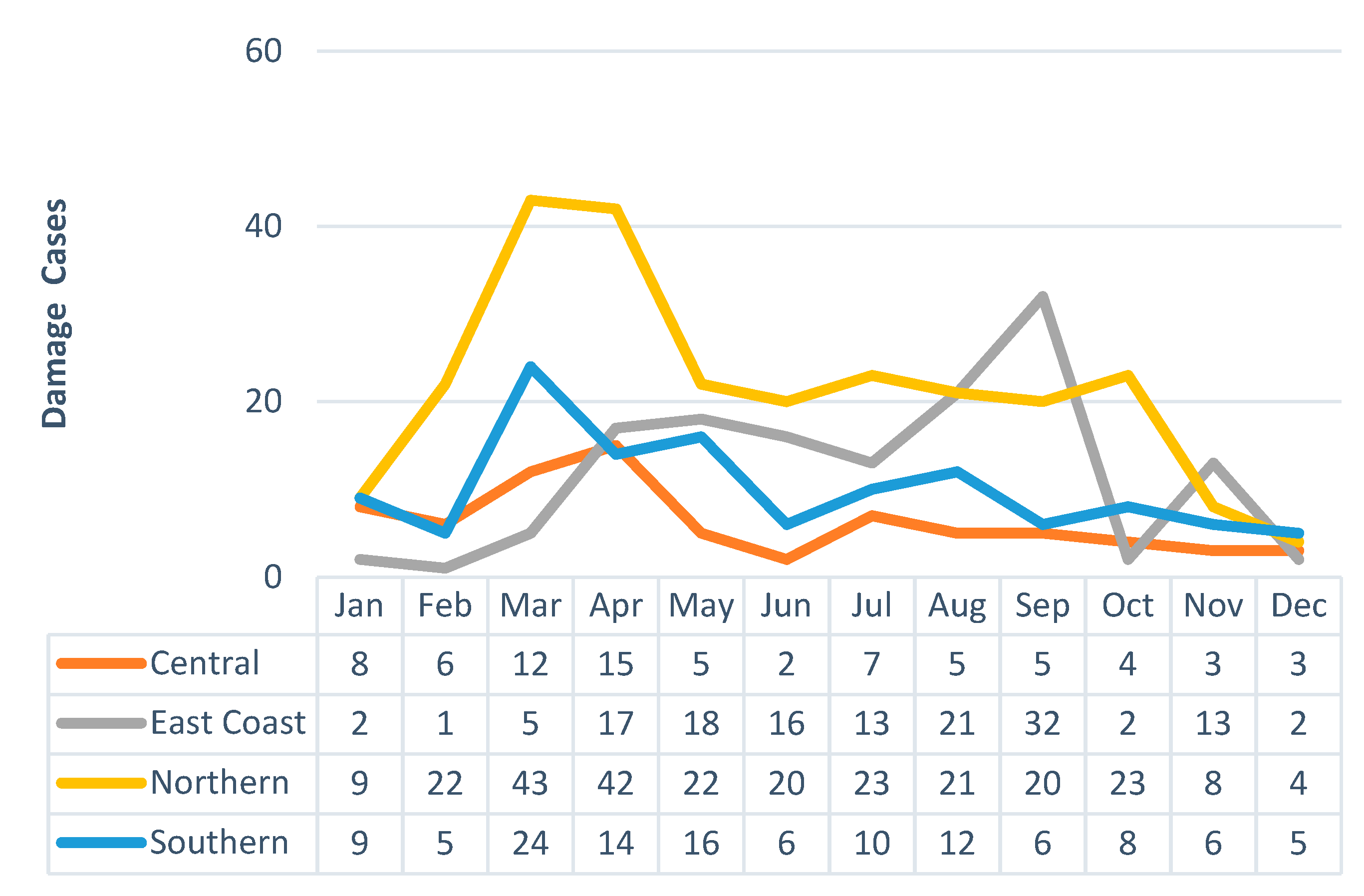
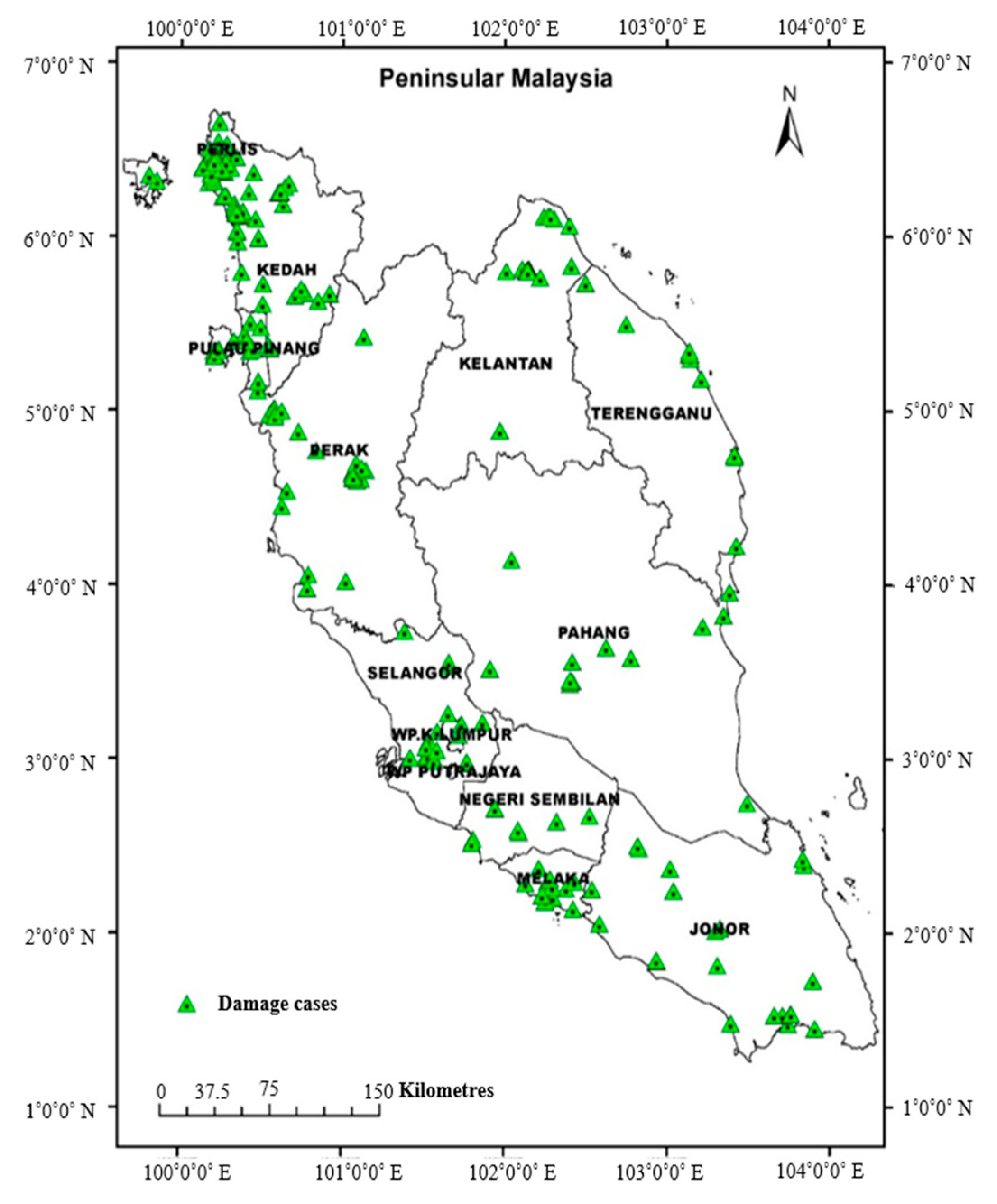

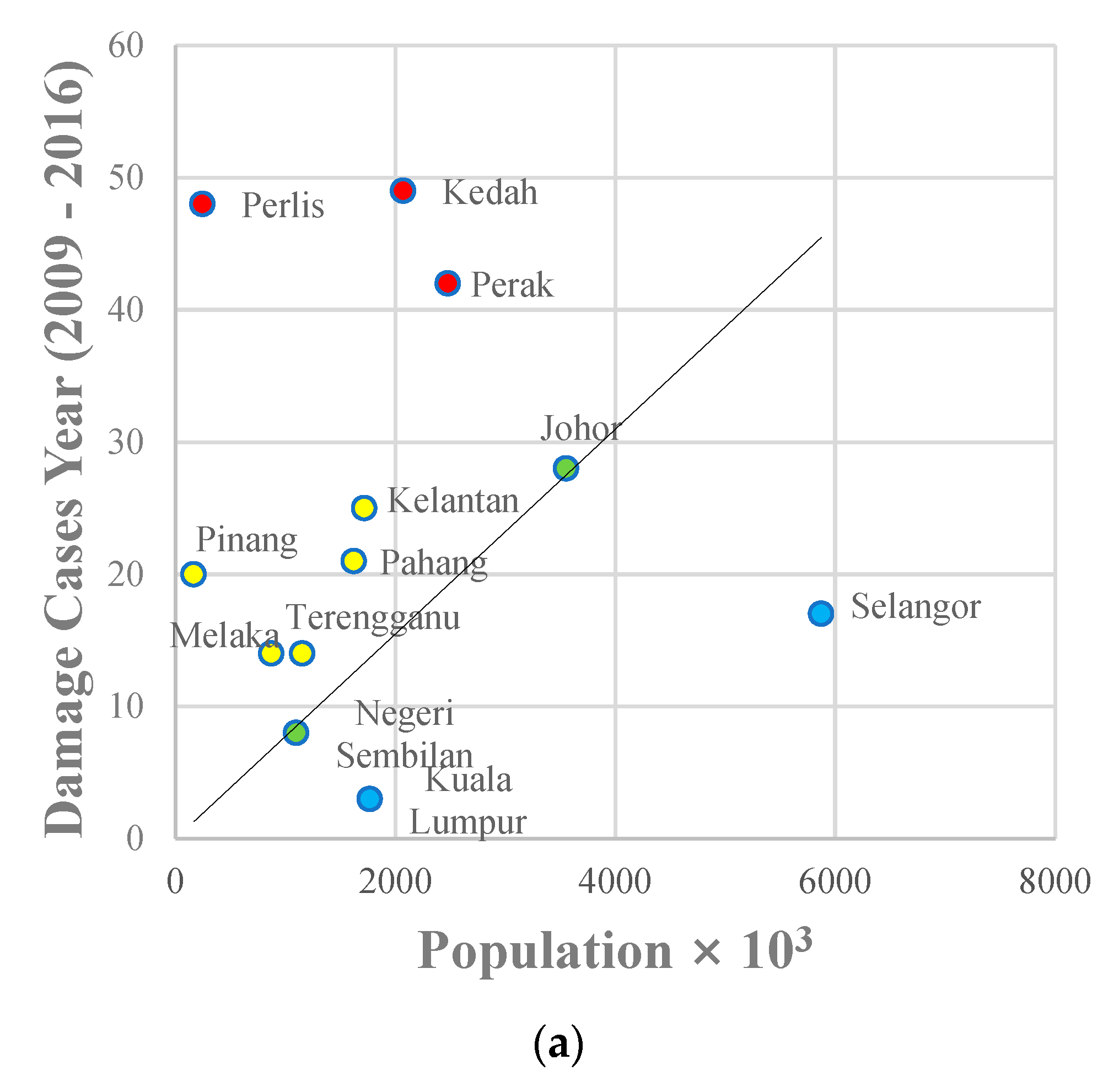
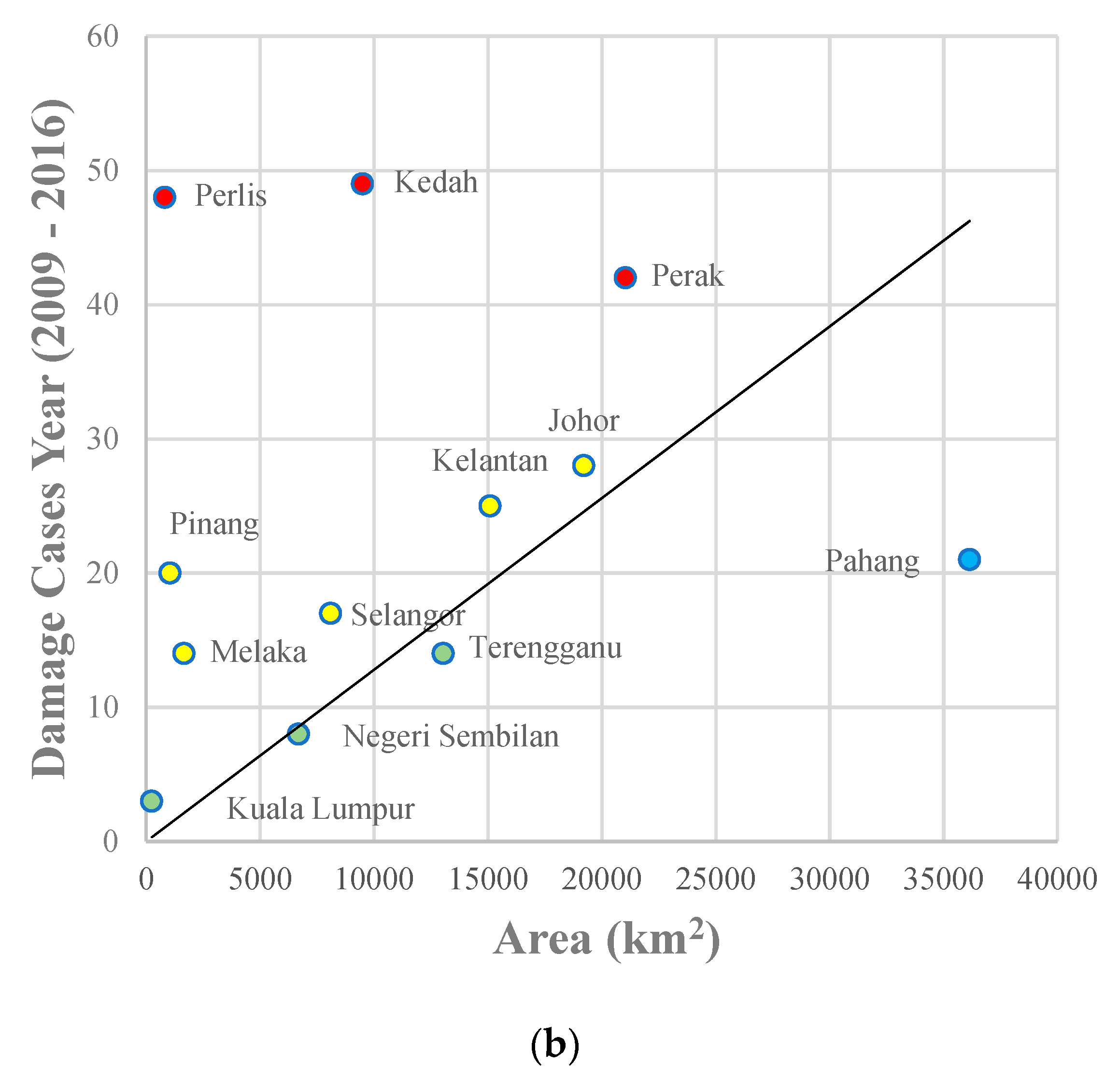
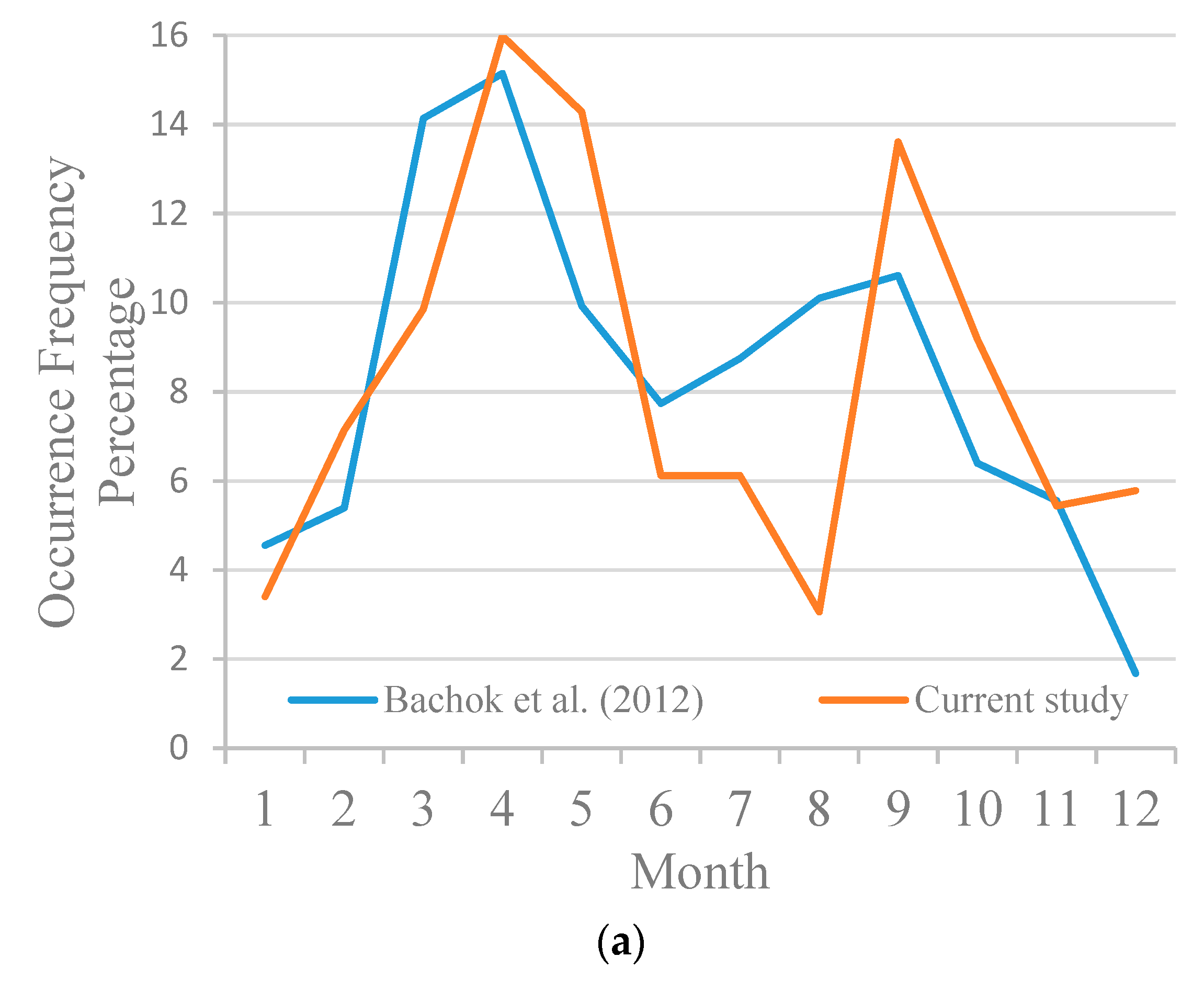
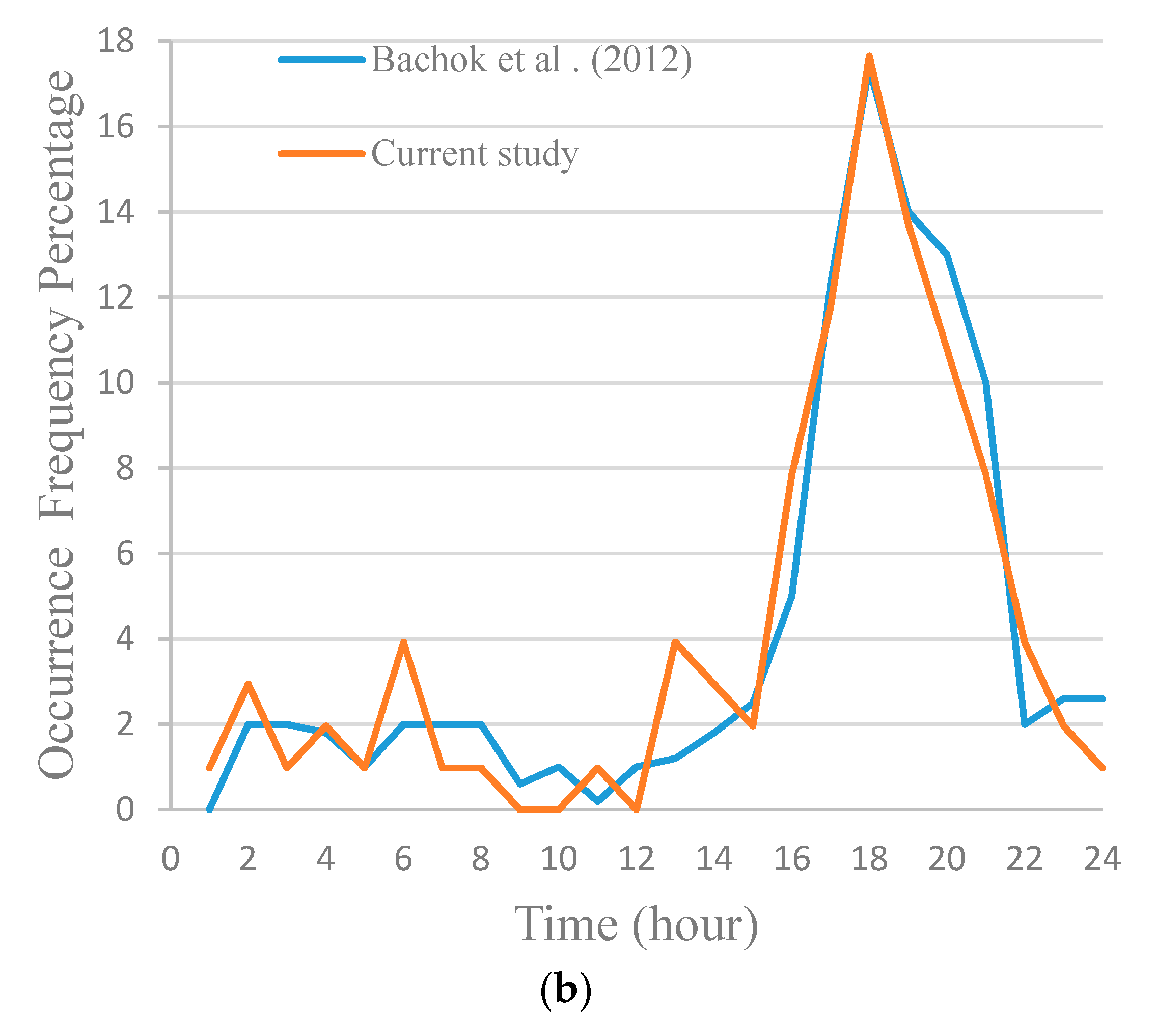

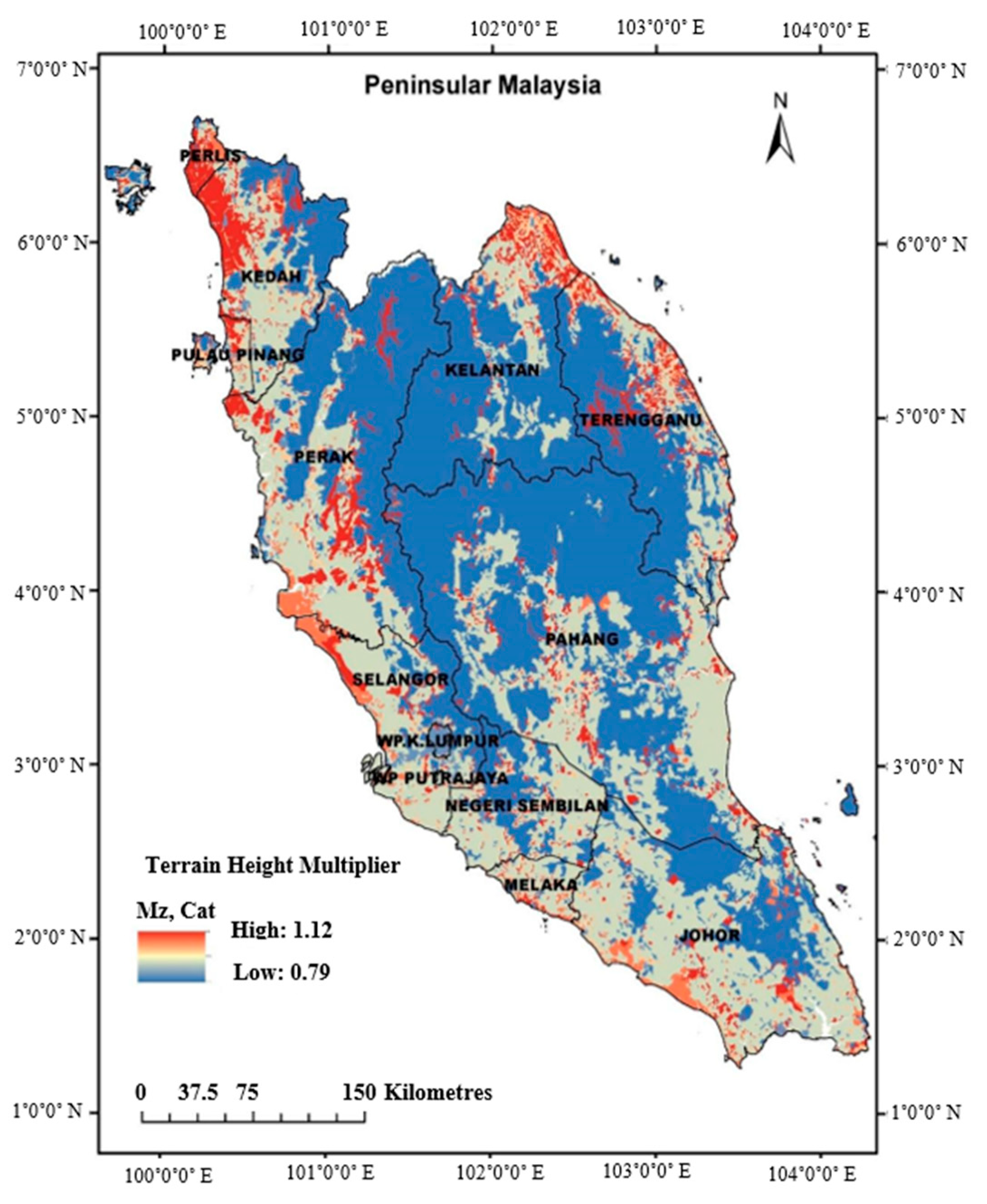
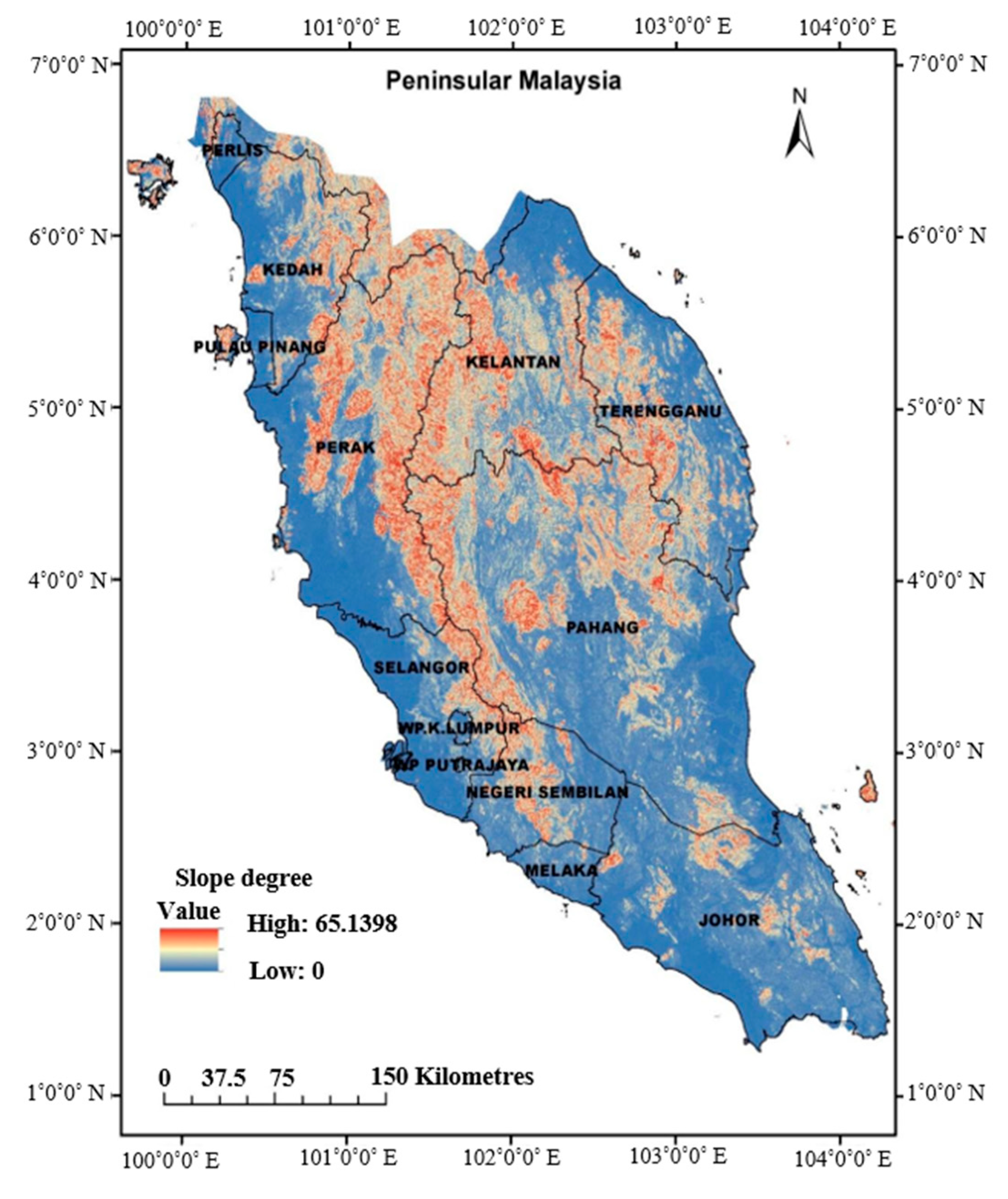
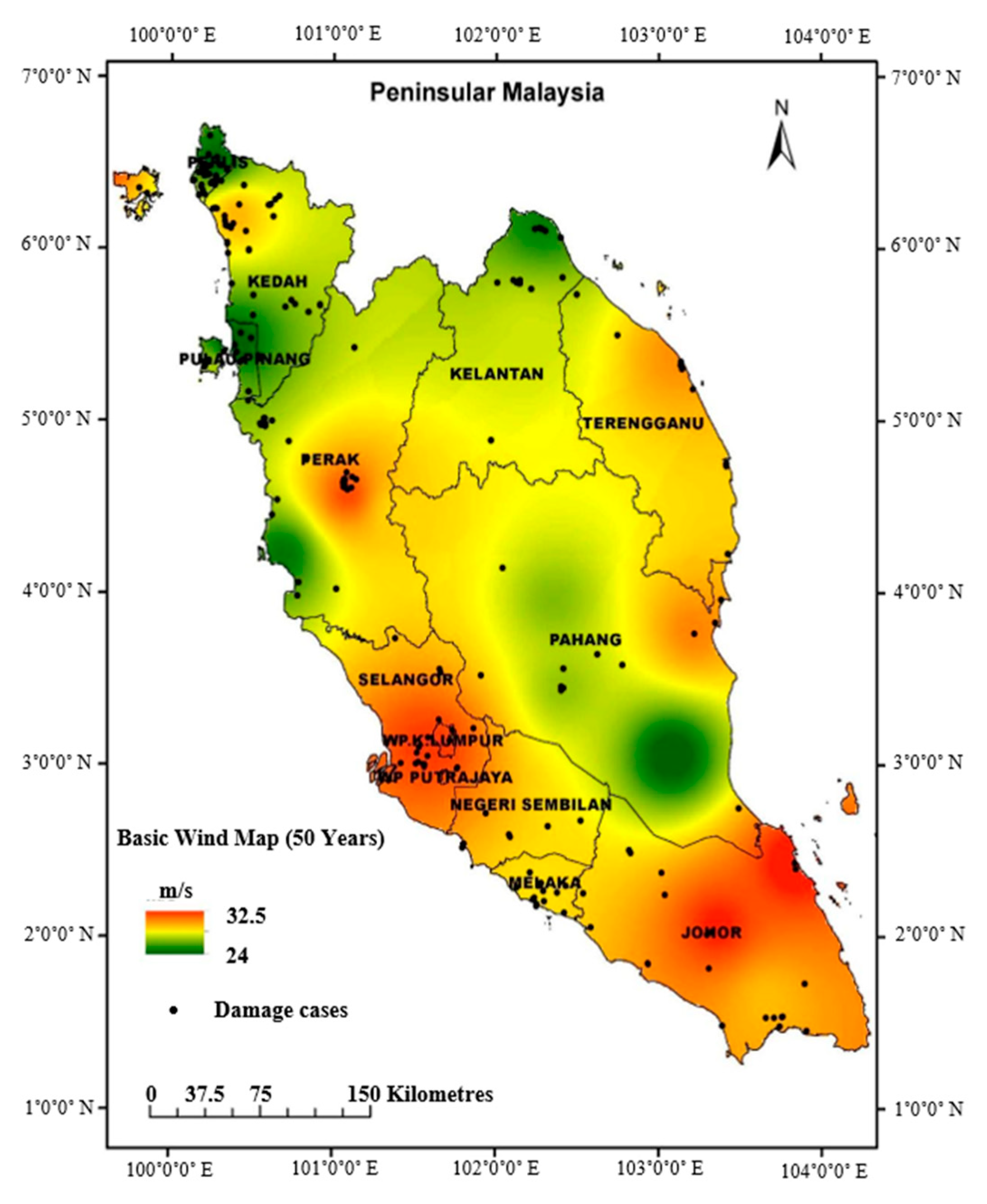
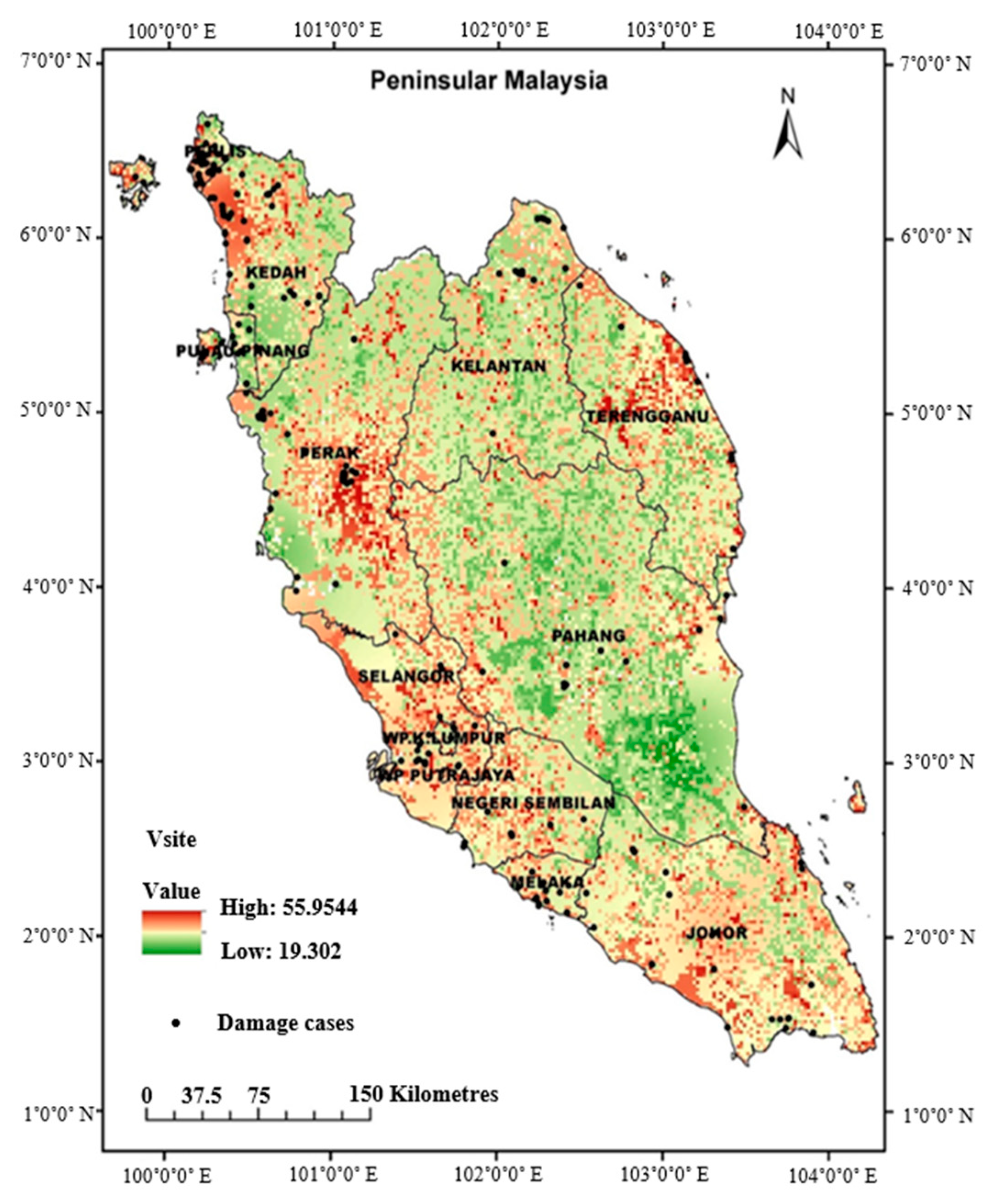
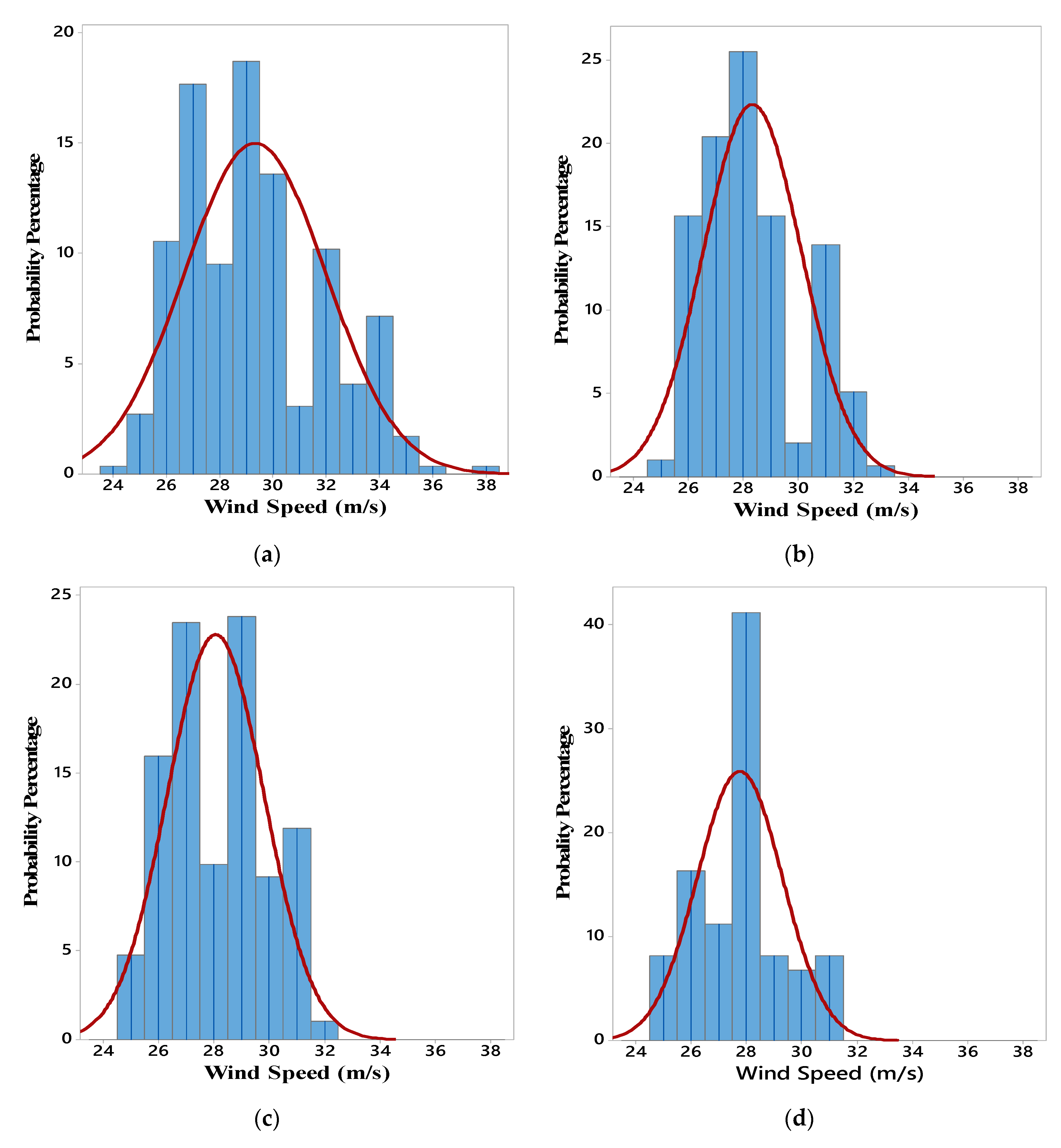
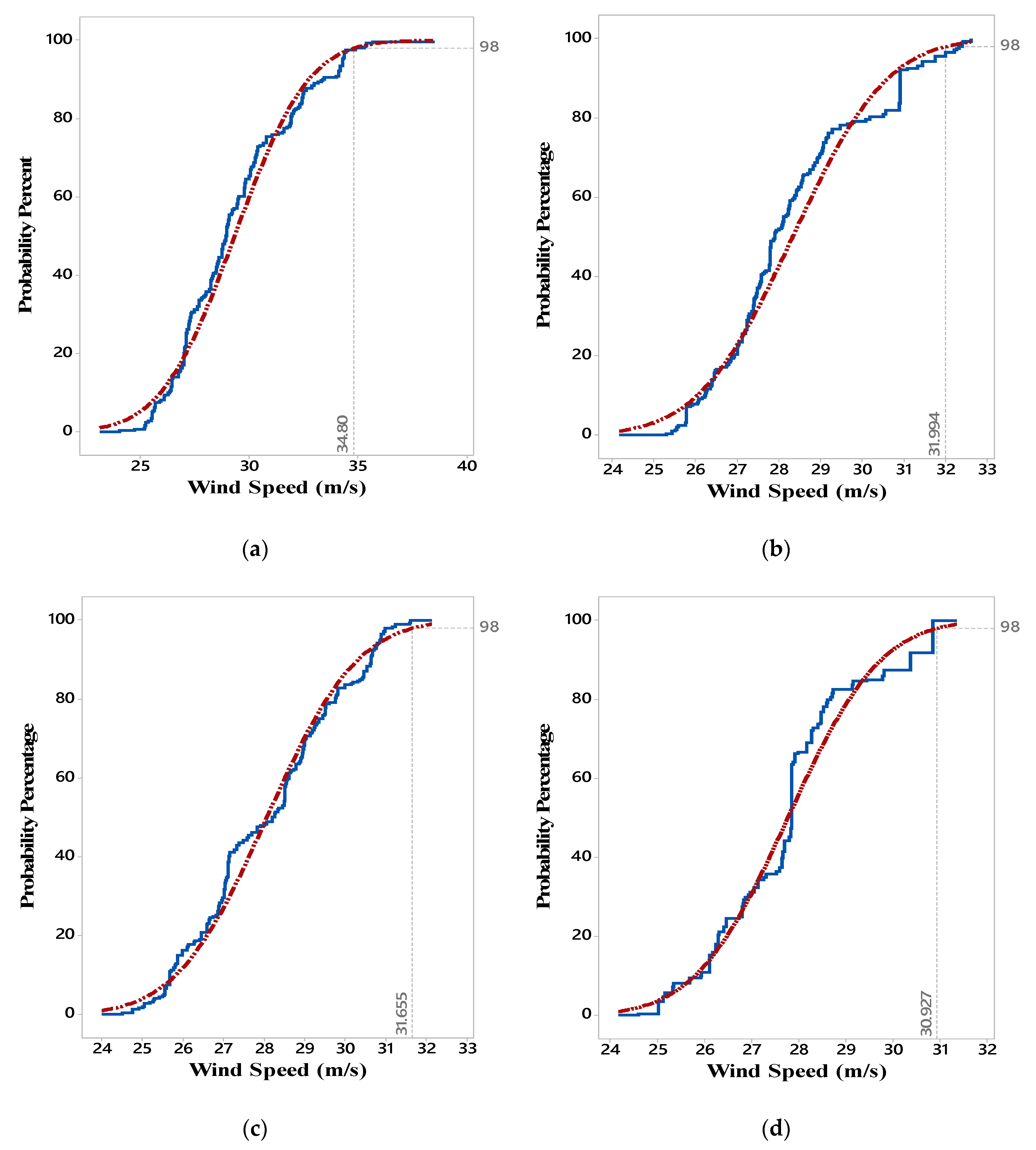
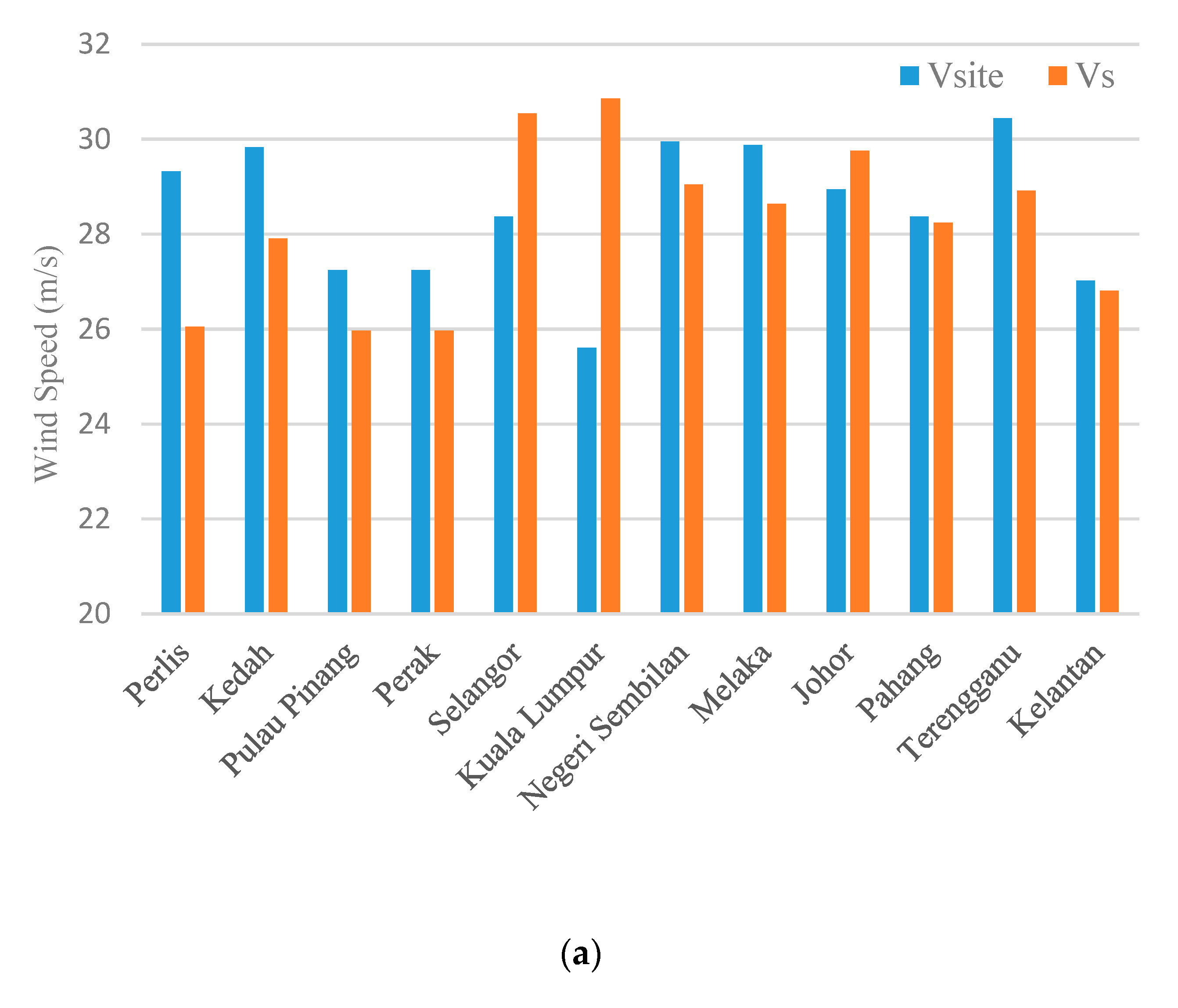
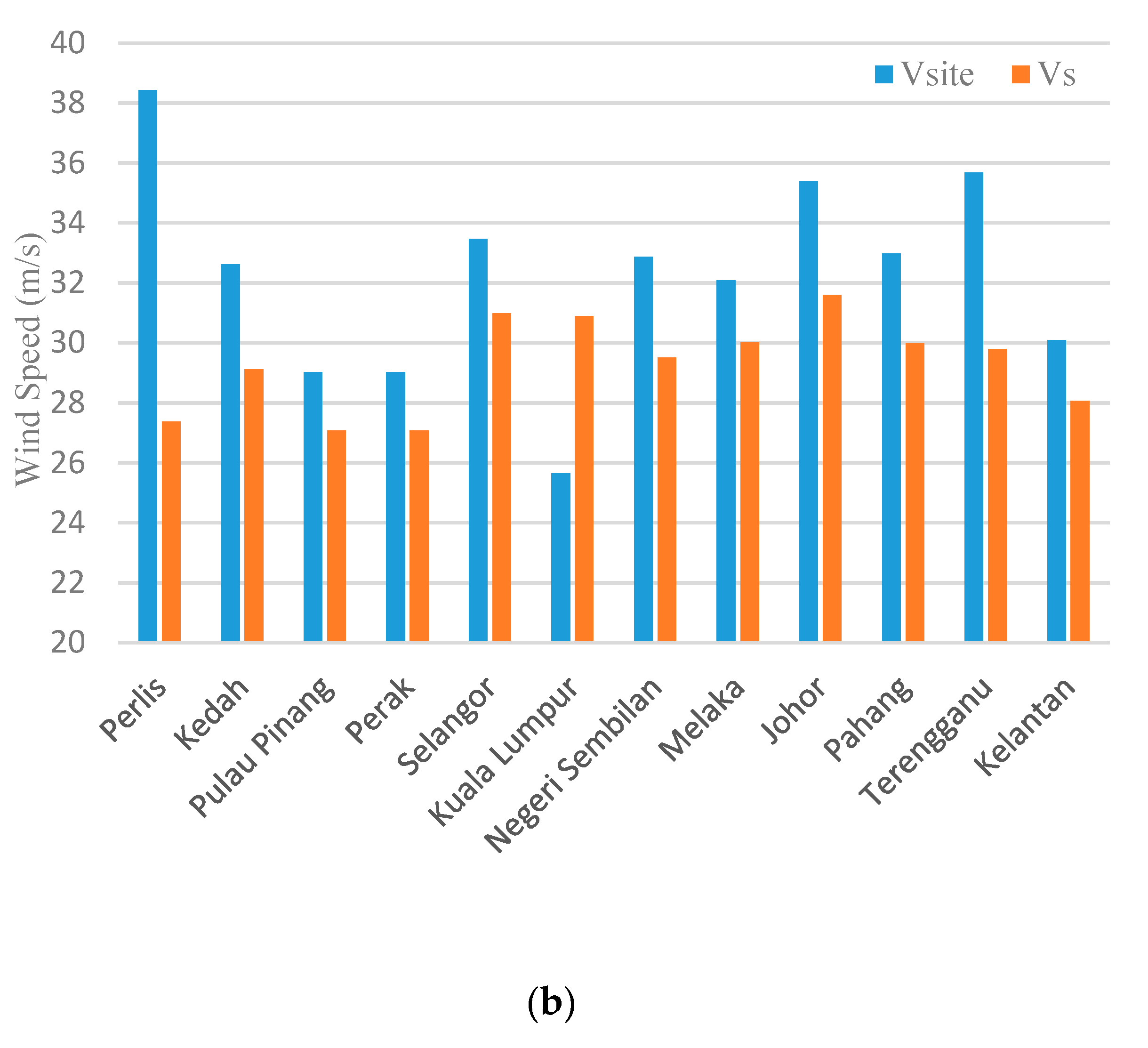
| Start Date | End Date | Location | Disaster Subtype | Total Death | Total Affected | Associated Disaster |
|---|---|---|---|---|---|---|
| 07/01/1968 | 07/1/1968 | Johor | Nil | 21 | 10,000 | - |
| 26/12/1996 | 28/12/1996 | Sabah | Tropical Cyclone | 270 | 4176 | Flood |
| 23/8/1997 | 27/8/1997 | Kedah, Perlis, Penang | Tropical Cyclone | 2 | 2115 | Flood |
| 23/8/1997 | 27/8/1997 | Kedah, Perlis, Penang | Tropical Cyclone | 2 | 2115 | Flood |
| 27/9/2000 | 27/9/2000 | Penang | Nil | - | 500 | Nil |
| 30/3/2002 | 30/3/2002 | Klang | Convective Storm | 2 | 155 | - |
| 16/7/2004 | 16/7/2004 | Kedah State | Nil | - | 1000 | Nil |
| 06/11/2004 | 06/11/2004 | Kuala Lumpur | Nil | 1 | 40,000 | Flood, Land Slide, Mud |
| No | Station | 50-year Return Period Wind Speed (m/s) | Period | No | Station | 50-year Return Period Wind Speed (m/s) | Period |
|---|---|---|---|---|---|---|---|
| 1 | Chuping | 25 | 1972–2012 | 11 | Melaka | 28.5 | 1941–2012 |
| 2 | Alor Setar | 29.2 | 1939–2012 | 12 | Kluang | 31.3 | 1974–2012 |
| 3 | Butterworth | 24.5 | 1985–2012 | 13 | Senai | 29.1 | 1974–2012 |
| 4 | Bayan Lepas | 27.2 | 1985–2012 | 14 | Mersing | 31.6 | 1939–2012 |
| 5 | Ipoh | 30.8 | 1939–2012 | 15 | Muadzam Shah | 24.4 | 1983–2012 |
| 6 | Sitiawan | 25.3 | 1939–2012 | 16 | Temerloh | 27 | 1978–2012 |
| 7 | Batu Embun | 26.8 | 1983–2012 | 17 | Kuantan | 30 | 1950–2012 |
| 8 | Cameron Highlands | 28.7 | 1983–2012 | 18 | Kuala Terengganu | 29.8 | 1978–2012 |
| 9 | Subang | 31 | 1966–2012 | 19 | Kota Bahru | 32.4 | 1939–2012 |
| 10 | Petaling Jaya | 31 | 1971–2012 | 20 | Kuala Krai | 27.6 | 1985–2012 |
| Category | Degree | Upwind Slope | Mh |
|---|---|---|---|
| 1 | <2.9% | <0.05 | 1.00 |
| 2 | 2.9 | 0.05 | 1.08 |
| 3 | 5.7 | 0.1 | 1.16 |
| 4 | 11.3 | 0.2 | 1.33 |
| 5 | 16.7 | 0.3 | 1.49 |
| 6 | ≥24.2 | 0.44 | 1.71 |
| Category | Description | Mz, cat |
|---|---|---|
| 1 | Exposed open terrain with few or no obstructions, e.g., open sea. | 1.120 |
| 2 | Water surfaces, grasslands with few well-scattered obstructions with a height generally from 1.5 m to 10 m. | 1.060 |
| 3 | Open Terrain: Mixed area between few well-scattered obstructions with a height generally from 1.5 m to 10 m, with terrain with numerous closely spaced obstructions from 3.0 m to 5.0 m. | 1.000 |
| 4 | Terrain with numerous closely spaced obstructions from 3.0-m to 5.0-m high, such as areas of suburban housing. Low crops. | 0.9150 |
| 5 | Terrain with numerous large, high (10.0 m to 30 m), and closely spaced obstructions, such as large city centers and well-developed industrial complexes. High crops. Scattered obstacles. | 0.8300 |
| 6 | Regular large and close obstacle coverage, such as deep forest areas. | 0.7500 |
| Terrain Category | Number of Cases | Percentage (%) |
|---|---|---|
| 6 | 1 | 0.35 |
| 5 | 8 | 2.77 |
| 4 | 45 | 15.57 |
| 3 | 106 | 36 |
| 2 | 9 | 3.11 |
| 1 | 125 | 42.52 |
| Category | Degree | Mh | Damage Cases | Percentage (%) |
|---|---|---|---|---|
| 1 | <2.9 | 1 | 264 | 89.8 |
| 2 | 2.9 | 1.08 | 22 | 7.48 |
| 3 | 5.7 | 1.16 | 6 | 2.04 |
| 4 | 11.3 | 1.33 | 2 | 0.68 |
| 5 | 16.7 | 1.49 | 0 | 0 |
| 6 | >24.2 | 1.71 | 0 | 0 |
| Variable | Windstorm Damage | Mean (m/s) | Standard Deviation | Min (m/s) | Q1 (m/s) | Median (m/s) | Q3 (m/s) | Max (m/s) | Skewness |
|---|---|---|---|---|---|---|---|---|---|
| Vsite | 294 | 29.334 | 2.66 | 24.033 | 27.126 | 28.956 | 30.787 | 38.431 | 0.59 |
| Vs | 294 | 28.062 | 1.75 | 24.501 | 26.801 | 28.226 | 29.373 | 31.599 | 0.07 |
| Vmukim | 294 | 28.326 | 1.79 | 25.285 | 27.109 | 27.895 | 29.16 | 32.621 | 0.61 |
| VDistrict | 294 | 27.763 | 1.54 | 24.592 | 26.783 | 27.838 | 28.473 | 30.844 | 0.34 |
| State | The 50-year Return Period Wind Speed (m/s) | Difference (%) | |
|---|---|---|---|
| Vsite | Vs | ||
| Perlis | 33.06 | 27.18 | 17.79 |
| Kedah | 34.67 | 30.09 | 13.21 |
| Pulau Pinang | 29.5 | 27.99 | 5.12 |
| Perak | 38.04 | 32.64 | 14.20 |
| Selangor | 33.43 | 31.78 | 4.94 |
| Negeri Sembilan | 35.17 | 29.9 | 14.98 |
| Melaka | 33.96 | 28.62 | 15.72 |
| Johor | 34.76 | 31.68 | 8.86 |
| Pahang | 33.29 | 30.61 | 8.05 |
| Terengganu | 35.64 | 30.58 | 14.20 |
| Kelantan | 29.38 | 28.34 | 3.54 |
| Peninsular Malaysia | 34.80 | 31.66 | 9.02 |
© 2020 by the authors. Licensee MDPI, Basel, Switzerland. This article is an open access article distributed under the terms and conditions of the Creative Commons Attribution (CC BY) license (http://creativecommons.org/licenses/by/4.0/).
Share and Cite
Abo Sabah, S.H.; Ramli, N.I.; Majid, T.A.; Zaini, S.S. Development of Site-Specific Wind Hazard Map for Peninsular Malaysia via Spatial Modeling. Energies 2020, 13, 729. https://doi.org/10.3390/en13030729
Abo Sabah SH, Ramli NI, Majid TA, Zaini SS. Development of Site-Specific Wind Hazard Map for Peninsular Malaysia via Spatial Modeling. Energies. 2020; 13(3):729. https://doi.org/10.3390/en13030729
Chicago/Turabian StyleAbo Sabah, Saddam Hussein, Noram Irwan Ramli, Taksiah A. Majid, and Shaharudin Shah Zaini. 2020. "Development of Site-Specific Wind Hazard Map for Peninsular Malaysia via Spatial Modeling" Energies 13, no. 3: 729. https://doi.org/10.3390/en13030729
APA StyleAbo Sabah, S. H., Ramli, N. I., Majid, T. A., & Zaini, S. S. (2020). Development of Site-Specific Wind Hazard Map for Peninsular Malaysia via Spatial Modeling. Energies, 13(3), 729. https://doi.org/10.3390/en13030729




